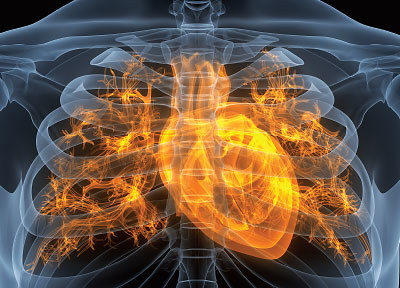Cardiac Cycles Appear Linked to Perceptions of Threat and Fear
Abstract
The heart’s cycles of contraction (systole) and relaxation (diastole) appear to mediate perceptions of pain and fear. The findings could have clinical implications, especially for understanding the physiological reactions in PTSD.

The human heart has long served as a metaphor for that which is emotionally essential—and a growing body of research has shown that our hearts really do color our perceptions of the world and what is safe or dangerous.
A study by neuroscientist Sarah Garfinkel, Ph.D., and colleagues in press in the Journal of Experimental Psychology titled “Cardiac Signals Enhance Fear Memories” builds on earlier work by Garfinkel and others who found that while systole decreases pain perception, it heightens perceptions of threat, and thereby fear, and changes the way in which subjects assess the emotional intensity of photographs of faces flashed on a screen.
“The physiological state of our body shapes the intensity with which we experience and remember the world,” wrote Garfinkel. “This study adds to evidence for how dynamic cardiovascular signals communicate with the brain to augment fear and threat responses” and provides further evidence that “stimulus processing at cardiac systole can significantly enhance fear reactivity.”
Garfinkel and colleagues found that individuals with higher trait anxiety (based on the Spielberger State-Trait Anxiety Inventory) reacted more strongly to external threat stimuli during systole (versus diastole) than those with lower trait anxiety. The subjects were exposed to both neutral stimuli and conditioning stimuli; conditioning stimuli included administration of mild electrocutaneous shock.
Garfield and colleagues then assessed subjects’ physiologic reactions using skin conductance response (SCR), electrocardiograms, and fingertip pulse oximeters. After establishing a baseline measure of conditioned fear response, the authors modified inputs to extinguish the acquired response. “Over the entire conditioning phase, the effect of the cardiac cycle dominated SCRs, ... which were significantly elevated at systole relative to diastole,” Garfinkel commented.
While the study confirmed earlier work showing that systole heightens fear response, it also found that systole affected associative learning of threat and safety, with implications for possible treatment of posttraumatic stress disorder (PTSD) and other anxiety disorders, she noted. The earlier study, titled “Fear From the Heart: Sensitivity to Fear Stimuli Depends on Individual Heartbeats,” was published in the May 7, 2014, Journal of Neuroscience.
Results from the current study could lead eventually to clinical applications in patients suffering from anxiety disorders, observed coauthor Hugo Critchley, M.B.Ch.B., D.Phil., chair of psychiatry at Brighton and Sussex Medical School in Brighton, U.K. “The therapeutic potential to use natural physiological fluctuations to change the value of emotive stimuli was central to the [study] grant,” said Critchley.
For instance, patients in the study treated by mental health clinicians were screened to determine whether cardiac interoception—including heart-timing effects of fear and threat—predicted six-month outcomes with drugs or other therapies. The grant also included a study using heart cycle timing in computerized exposure therapy. (The authors are still analyzing the results of this research and hope to have them published, Critchley said. They are also compiling an overview of studies related to how cardiac cycle timing of simulated collisions affects simulated driving.)
In a discussion of the research, Garfinkel commented that “by understanding how such embodied mechanisms give rise to persistent and recurrent fear memories, this work may help foster novel approaches targeting brain-body interactions to treat fear-related disorders—notably PTSD.”
While the research is intriguing, many pieces of the puzzle must be evaluated before clinicians can apply it on a meaningful scale for patients with anxiety disorders, commented psychiatrist Sahib Khalsa, M.D., Ph.D., director of clinical operations at Laureate Institute for Brain Research and an associate professor at the University of Tulsa Oxley College of Health Sciences, both in Tulsa, Okla.
A key limitation is that the findings need to be replicated in a clinical setting to see if they hold up. Also, said Khalsa, most of the subjects were “at the lower end of trait anxiety,” which makes it difficult to say how people with PTSD or other high-trait anxiety disorders would react.
Anxiety disorders such as PTSD may be triggered by both single intense traumatic events (for example, a blast from an improvised explosive device) or by exposure to an ongoing series of traumatic events, such as may occur in combat or in a situation of chronic sexual abuse, Khalsa noted.
“From a clinical perspective, this is relevant because on both the acquisition and extinction side, episodes that are thought to induce trauma or a stress disorder [may] happen during a prolonged period of arousal,” Khalsa observed. Whether this would be directly relevant in terms of the timing of stressors with systole-diastole is unclear, he said.
The study was supported by a European Research Council grant to Critchley and Garfinkel, who are affiliated with the Sackler Center of Consciousness Science. The Sackler Center is supported by the Mortimer and Theresa Sackler Foundation. ■



